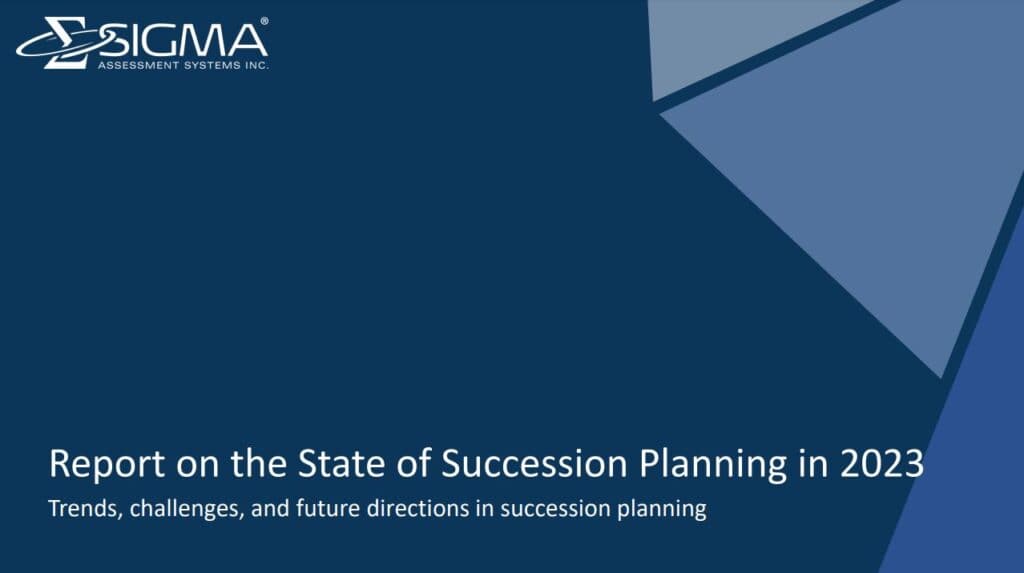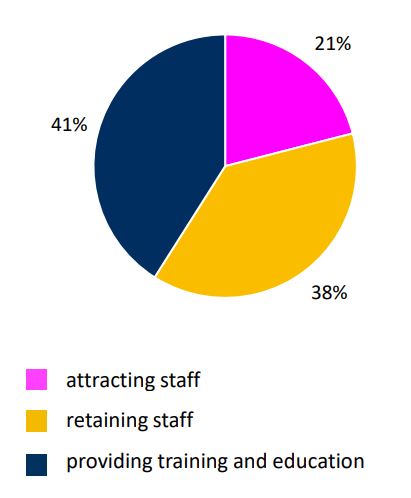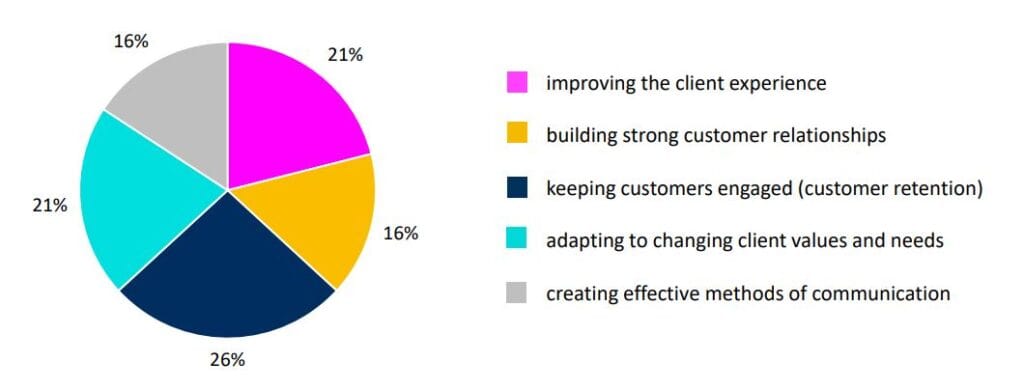Report on the State of Succession Planning
Welcome to SIGMA’s report on the state of succession planning. In this report, our consultants take a deep dive into the state of the global succession planning industry. We analyze our latest client data to provide insights into trends, challenges, and future directions of succession planning.

Report Summary
- Chapter 1: What is Succession Planning
- Chapter 2: Why Succession Planning Matters
- Chapter 3: Common Barriers to Succession Planning
- Chapter 5: BONUS: Interview with the Experts
Chapter 1: What is Succession Planning
Succession planning is a strategic human resource (HR) initiative, and it is one of the most important talent development practices an organization will undertake. Everyone benefits from intentional leadership development and smooth succession — in other words, a proper succession planning process. A key aspect of succession planning is the identification of an internal talent pool, also known as a leadership pipeline, that feeds into each of an organization’s critical roles — the roles that have the greatest impact on an organization’s performance.
What is Effective Succession Planning?
Effective succession planning is:
- Ongoing
- Strategic
- Long-term
- Structured
- Standardized
- Objective
Succession Planning vs. Replacement Hiring
When most people use the term “succession planning,” what they are really referring to is replacement hiring. Replacement hiring is the process of selecting or hiring a replacement without any long-term talent development to support the process. Download the report to learn more about the difference between replacement hiring and true succession planning.
Internal vs. External Hires
Replacement hiring often results in external candidates being selected for succession, as the organization does not have qualified internal talent available at the time of the vacancy. External candidates can certainly be strong successors, however, when it comes to onboarding an external hire vs. an internal hire, there are a few distinct challenges an external hire will face:
- Knowledge
- Relationships
- Onboarding
5 Myths About Succession Planning
There are a few other misconceptions about the nature of succession planning. Below are five common myths we’ve encountered in our work with clients:
- Succession planning is just for CEOs.
- Succession planning is just for people who are retiring.
- Succession planning is HR’s job.
- Succession planning is not necessary for flat organizations.
- Succession planning is irrelevant for family firms.
Chapter 2: Why Succession Planning Matters
Without a defined succession plan in place, a vacancy to a critical role can create confusion and be a massive risk to an organization’s stability. Almost 60% of leaders agree that the risk of not having a succession plan is high, and 48% of leaders understand that succession planning has significant cultural, operational, and financial benefits.
A robust succession planning process strengthens important success factors in an organization’s:
- Culture
- Operations
- Finances
Cultural Benefits of Succession Planning
Organizations that have a succession planning process demonstrate commitment to long-term stability. This can be both reassuring and motivating for employees. Beyond offering reassurance, being a part of a succession planning process can be highly motivating for employees who are invested in their personal and professional development. Therefore, succession plans can boost employee motivation and performance too.
Operational Benefits of Succession Planning
Some of the operational benefits of having a strong succession plan include increased employee morale, greater job satisfaction and commitment to the organization, and an improved ability to attract and retain talent. Succession planning also helps organizations build a talent bench around each critical role.
Financial Benefits of Succession Planning
Many are unaware of the fact that a strong succession plan saves money, and that there are costs to not having a plan. Having a strong succession plan increases organizational productivity, reduces down-time during onboarding, helps to sustain client relations, and boosts investor confidence in the organization.
To learn more about the cultural, operational, and financial benefits of succession planning, read the full report.
Chapter 3: Common Barriers to Succession Planning
A key step in building a succession planning process is to anticipate and prepare for adversity. SIGMA helps clients prepare for adversity by guiding teams through common barriers to succession planning and sharing the challenges most organizations encounter when implementing a major strategic planning process. We’ve identified a few common hurdles that teams will likely encounter as they begin the succession planning process:
- Difficulty attracting and retaining talent
- Too much responsibility placed on one person
- Lacking leadership support
- Difficulty adapting to change
- Using a one-size fits all approach to development
- Lacking standardization
- Keeping the succession plan a secret
What the Numbers Show
Succession planning isn’t the only process affected by the challenges listed previously. SIGMA has noticed an overarching trend related to the difficulties of implementing any strategic process — not just succession plans. In fact, in our surveys of organizational leaders, we found that over 50% of organizations rarely implement strategic plans, or don’t create strategic plans at all.

Chapter 4: Themes in Succession Planning
When SIGMA meets with clients, one of the first discussions we have is concerned with future directions. We ask clients to identify risks and opportunities around the themes of talent, innovation, their customers, and the industry. The top three future directions we have identified in our recent work with clients are as follows:
- Recruiting and retaining staff
- Keeping up with innovation
- Improving customer experience

Recruiting and Retaining Staff
It’s no surprise that today’s leaders are focused on recruiting and retaining staff. In 2021, the U.S. Bureau of Labor Statistics reported that more than 4 million workers quit their job each month. Consequently, a record breaking 10.9 million jobs were vacant at the end of July.
Among organizations focused on recruiting and retaining staff, 41% are focused on providing training and education, 38% are focused on retaining staff, and 21% are focused on attracting staff.
Keeping Up With Innovation
In our conversations with leaders, SIGMA has noticed a growing awareness among organizations that industries and markets are changing drastically, largely due to the influence of emerging and developing technologies. Nearly 1 in 10 leaders tell us that their priority is to stay current with industry knowledge, and more than 1 in 4 highlight a desire to keep up with innovation. For those leaders, there are some commonalities in how they intend to approach innovation:

Improving Customer Satisfaction
Nearly a quarter of all leaders tell us that the future of their organization depends on the satisfaction of their customers. In order to improve customer satisfaction leaders told us that they are focusing on:

Common Critical Competencies
Leadership competencies are an important part of our discussion regarding succession planning themes. Based on data collected to date, here are the top 10 competencies that organizations want to see in their leaders:
- Communication.
- Strategic Planning.
- Integrity.
- Developing and Coaching Others.
- Facilitating Teamwork.
- Active Listening.
- Decisiveness.
- Prioritizing.
- Assuming Responsibility.
- Vision.
Common Strengths and Development Competencies
In addition to common critical competencies, it is important to highlight common strengths and development opportunities. These are the competencies that succession candidates often score well on (strengths), and the ones where we commonly see room for improvement (development opportunities):
Strengths
- Open-mindedness.
- Integrity.
- Risk-taking.
- Delegation.
- Decisiveness.
Development Opportunities
- Thoroughness.
- Monitoring and Controlling.
- Organizing the Work of Others.
- Short-term Planning.
- Self-discipline.
Chapter 5: BONUS: An Interview with the Experts
We asked our consultants some of the most pressing succession planning questions. These questions include:
- What motivates organizations to approach you for succession planning support?
- What types of organizations do you see most in your consulting?
- What are the common challenges that organizations face during succession planning?
- How can organizations encourage buy-in to their succession plan?
- What is the future of succession planning?
- What advice would you give to organizations starting a succession plan for the first time?
To find out what SIGMA’s expert consultants had to say, download the full report.
Navigate the Succession Planning Process with SIGMA
Explore the latest trends, insights, and strategies in succession planning with SIGMA’s comprehensive report, designed to help you navigate the complexities of leadership transitions.
Need Help Getting Started?
SIGMA’s Succession Planning Launch offers a simple and cost-effective way to build a robust Succession Planning process and ensure your organization’s leadership is positioned for success and prepared for the unknown. Contact us to learn how we deliver a detailed 12-month succession plan for each member of your leadership team in just two half-day workshops.